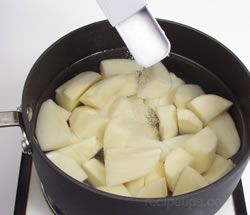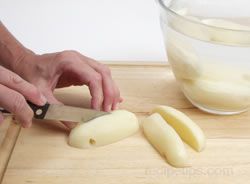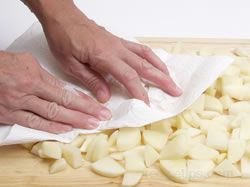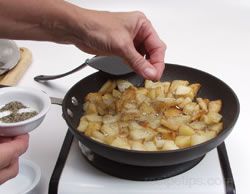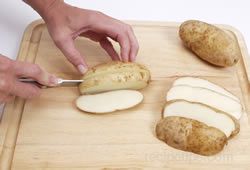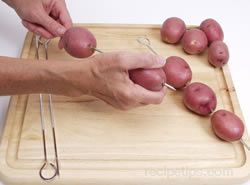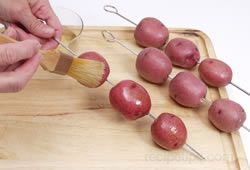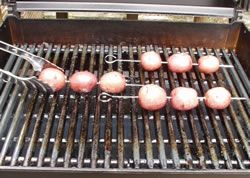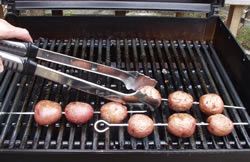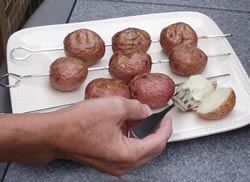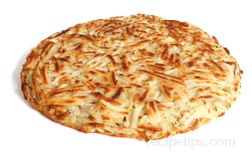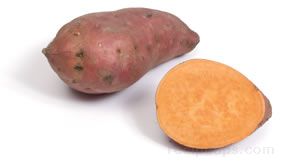|
Tools for Preparation | Potato Preparation | Potato Cooking | Tips
| Potatoes |
|
   
The most popular tuber vegetable in the world. It is available in hundreds of varieties, which vary in size, shape, taste, color, and starch content. Potatoes contain 20% indigestible starch, which makes it necessary to cook them in some manner before consuming. Potatoes can be cooked using most any cooking method desired. They are also converted into commercial products, such as potato chips, instant mashed potatoes, canned new potatoes and many frozen products including French fries, hash browns, and stuffed baked potatoes. |
| Uses:
Potatoes are often served as a side dish to meat and poultry, but they are also used as a significant ingredient in many dishes, such as stew, soups, scalloped potatoes, and other casserole type dishes. They are a major ingredient in the Scandinavian flat bread, Lefse. Some varieties are better for specific purposes than others, such as red potatoes, which are best for boiling, and russets, which are best for frying and baking. They are also converted into commercial products, such as potato chips, instant mashed potatoes, canned new potatoes and many frozen products including French fries, hash browns, and stuffed baked potatoes. |
|
How to Buy:
When selecting, choose those that are firm and plump, avoiding those that have shriveled skins, sprouting eyes, soft spots, blemishes and green spots. |
|
Storage:
Store potatoes in a cool dry place. They will keep at room temperature for up to two weeks and longer when stored in cool temperatures. If potatoes are purchased in a plastic bag, remove them from the bag and place in a basket or other such type of a container so that they will have proper air circulation. A paper sack would be better than plastic because the plastic will trap moisture. Do not store in the refrigerator because the cold temperatures will convert the starches into sugar and the potato will become sweet and turn a dark color when cooked. Do not store with onions, the gas given off by onions accelerate the decay of potatoes. |
| Varieties: |
| Long White Potato |
A long, oval potato with a thin skin that is tan in color and has very subtle eyes. They have a medium starch level and when cooked their texture is firm and creamy. They can be cooked using most any method of preparation, such as baking, boiling or frying. They are basically grown in California and can be found in the spring and all through the summer. |
| Round White Potato |
A variety of potato that is more evenly round and a bit smaller than the russet potato. The round white potato a medium level of starch, which is less starch than the russet and a finer texture. With a white colored, dense flesh, this potato provides a creamy textured result after being cooked, producing meat that holds its shape well. Round white potatoes are best suited to boiling than baking so it is a good choice for making mashed potatoes. |
|
Russet Potato
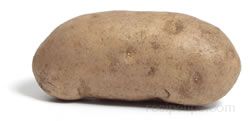
|
A brown skinned, oblong potato with a white interior, which is one of the most popular potatoes. It has a rough skin with numerous eyes and can grow quite large. The russet is low in moisture and high in starch, making it good for baking, boiling and making French fries. They are sometimes referred to as an old potato or a baking potato. There are two common varieties of Russet potatoes. The most popular variety is the Russet Burbank, which has an oblong shape and medium skin that is light brown in color. It has a white flesh, which bakes up light and fluffy. Another variety is the Russet Norkotah. It is also oblong in shape but has a heavier skin that is more appealing in appearance. It is not as light and fluffy when baked as the Burbank. Russet potatoes are available throughout the year. |
Red Potato
 |
They are medium sized with thin red skin and white flesh that has a crisp, waxy texture. The flesh can have a pink tint but is generally white. They are good potatoes for boiling, steaming, and roasting. They keep their shape when cooked, which makes them a good choice for dishes that have cooked potatoes in them, such as potato salad, scalloped potatoes, soups and stews. Red potatoes are available throughout the year. |
Klondike Rose
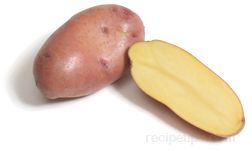 |
This red potato is different from other reds in that its flesh is a golden color. It is oval in shape and has smooth red skin. It has a delicious buttery taste and can be used for boiling, baking, steaming, mashing, and frying. When baked the skins turn brown. Klondike Rose potatoes are avavailable throughout the year in well stock supermarkets. |
|
Yukon Gold Potato
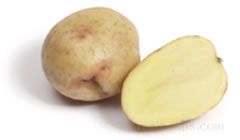
|
A variety of potato that has a light yellow skin and a rich buttery flavor. They are excellent for boiling and making mashed potatoes, but are not as good as russet potatoes for baking. They are also more expensive than many common potato varieties, but the flavor compensates for the price. Yukon potatoes are available as a large, mature potato for recipes requiring the larger size or as a small, young creamer potato for creamer recipes or other similar dishes requiring smaller sized potatoes. |
|
Creamer Potato
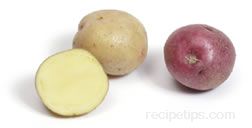
|
Varieties of potatoes that are harvested in the early stages of its growth, before it matures, in order to keep it small and tender. Creamer potatoes will generally be a gold Yukon or a Red potato that is harvested at a young age, measuring approximately 1 inch in diameter. The yellow or red skin of this potato is waxy and high in moisture while the sweet, tender white flesh contains a lower level of starch, making it an excellent boiling potato. Creamer potatoes can be boiled, baked, fried, or roasted and are excellent as side dishes or for use in potato salads, soups, stews, and casseroles. The common use is for the potato dish known as creamed potatoes, which cooks the potatoes in a cream sauce with peas and onions. A larger version of this potato that usually measures 2 inches in diameter is referred to as a new potato, which is basically the same, except harvested later and thus, larger in size. |
|
New Potato

|
A variety of potato, which is harvested very early in its growth when it reaches approximately 2 inches in diameter. The waxy yellow or red skin of this potato contains a high level of moisture, while its sweet, tender white flesh contains a lower level of starch, making it very suitable for boiling. New potatoes can be boiled, baked, fried, or roasted and are excellent as side dishes or for use in potato salads, soups, stews, and casseroles. A smaller version of this potato is referred to as a creamer potato, which is basically the same, except harvested sooner and thus, smaller in size, measuring approximately 1 inch in diameter. |
|
Finger Potato
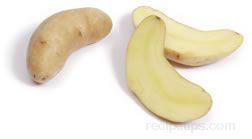 Austrian Crescent Austrian Crescent
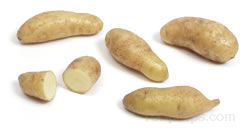 Buttercream Potato Buttercream Potato
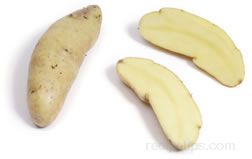
Russian Banana
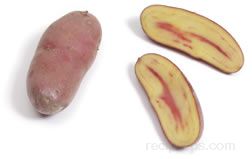
French Fingerling
|
A small, narrow potato (generally 2 to 4 inches in length) that is actually a very young tuber. The potato has a finger-like appearance and a firm texture that varies from moist to dry, with a flavor that ranges from mildly sweet to rich and nutty. Like many other potatoes, the finger potato can be baked, boiled, fried, grilled, roasted, steamed, or sautéed. There are a variety of different finger potatoes available. Also referred to as Fingerling Potatoes.
The Austrian Crescent is a good potato for boiling or steaming, providing a cream colored flesh that goes well in salads or side dishes. This potato may have a slight crescent shape or it may be somewhat straight in appearance.
The Buttercream is a smaller potato with a tan colored skin covering a cream-colored flesh that can be boiled, steamed or baked. It is not considered to be a good potato for salads since the texture is not firm and crumbles easily.
The Russian Banana, native to the Russian region, is tan skinned with a white to cream inner flesh. It can be baked, steamed, or fried to be served as a side dish or salad potato. It provides a rich buttery flavor.
The French Fingerling, which is more plump and oval than other varieties, has a red outer skin covering a moist cream-colored flesh that provides a somewhat nutty flavor. It can be baked, fried, grilled, sautéed, or steamed.
The Purple Peruvian, native to Peru, has a purple outer skin that covers a lavender colored flesh. Since this potato has a firm texture that cooks quickly, it can be baked, steamed, or microwaved for shorter periods of time than the yellow or white fleshed varieties. It is a good potato for salads.
The Ruby Crescent has a finger-like appearance with a ruby colored skin covering a cream colored flesh. This variety is firm textured and well suited for roasting or steaming to be served in salads or side dishes. |
Purple Potato
 |
A smaller oval-shaped potato with a purplish black outer skin and a vivid purple, dense inner meat. The odd colored meat adds a distinctive look to any dish. |
|
Sweet Potatoes
A tuber vegetable originating from Central America that is typically referred to as either a sweet potato or yam in the U.S. It is common for food stores to display and people to refer to the sweet potato as a yam, when it is actually a sweet potato. In the U.S. the term yam or sweet potato will generally refer to the orange-fleshed sweet potato that may be labeled as a Louisiana Yam. Outside of the U.S., a yam is not a sweet potato, but instead an actual vine-growing tuber that is moister than a sweet potato. When the sweet potato is referenced outside of the U.S. it is either the white or yellow-fleshed variety. The true sweet potato has a shape that can be elongated and tapered at each end, or somewhat oval with a rounded end. The yam, however, is typically a rougher skinned vegetable that may be long and cylindrical with a tapered end or be short and round in shape. |
|
Uses:
The pale variety of sweet potatoes can be substituted in most recipes that call for regular potatoes. They can be prepared by using most cooking methods, such as boiling, baking, frying, sautéing and microwaving. |
|
How to Buy:
When selecting, choose those that are firm and small to medium in size, choosing those that are similar in size so they will cook evenly. Avoid those that have shriveled skins, soft or decayed spots, or other blemishes. The bad spots in the potatoes can be cut away but a decayed or brownish black spot may have already caused the potato to have an unpleasant flavor. |
|
Storage:
Sweet potatoes should be stored in a cool, dark, dry place and used within a week after purchasing. The perfect conditions for storing sweet potatoes would be in a dark, dry location at 55°F, which would allow the potatoes to be stored for 3 to 4 weeks. Do not store in the refrigerator because too low of temperatures will convert the sugar to starch and cause an off flavor and a hard core. |
|
White or Yellow Fleshed
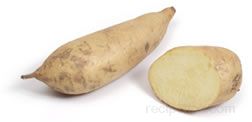
White Sweet
|
Sweet potatoes are often classified according to the color of their flesh; yellow, orange, white, or purple. The yellow, white and purple-fleshed tubers are most often marketed as a "sweet potato" while the orange-fleshed varieties are marketed as yams. The common varieties of the white sweet potato (boniato in Spanish) include Batata (Batata Dulce, Cuban Sweet, or Camote), Japanese Sweet, and White Sweet.
The white or yellow sweet potato may have an irregular light pale yellowish color or darker pale reddish-orange hues with a creamy, but drier texture that is not nearly as sweet or moist as the orange-fleshed variety. As a general rule, the potato will be drier textured and less sweet as the color of the flesh lightens. |
|
Orange Fleshed
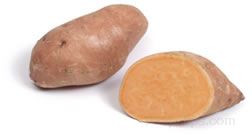 Beauregard Beauregard
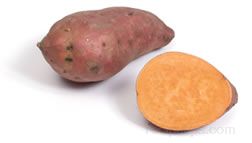
Red Garnet
|
Some of the common varieties of orange-fleshed sweet potatoes include, Beauregard, Jewel, and Red Garnet. Typically, the Beauregard is the variety most readily available in stores.
The orange or sweet variety generally has uniformity in color throughout their flesh, which can appear pinkish, orange, brown, or purple and are considered rich or sweet tasting. |
|
Okinawan (Purple Fleshed)
 |
The Okinawa or Okinawan is a purple-fleshed variety that is not as readily available. Covered by a thin whitish outer skin, this potato provides an enjoyable buttery and nut-like flavor. The Okinawan is also known as Tumai Kuru or Beni Imo. |
Tools for Preparation

Vegetable Peeler
A kitchen tool used to remove the outer skin from vegetables and some fruits, such as apples, by peeling them off in thin shavings. A peeler with a swivel type blade works the best because it can follow the contour of the vegetable or fruit, allowing thinner shavings to be removed.
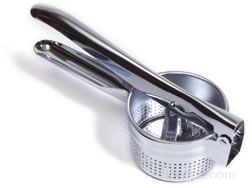
Potato Ricer
A kitchen utensil used to reduce whole soft foods, such as cooked potatoes and carrots into smaller bits. This utensil, much like a garlic press but larger, has an open chamber, which is generally 3 to 4 inches wide. A ram or plunger connected to the handle of the ricer is pressed down onto the food, forcing it through the many small holes in the bottom and, on some ricers, also on the sides of the container. As the food is extruded through the holes, it looks like strands or grains of rice. This utensil is also called a "ricer" and can be found in many stores offering baking utensils.
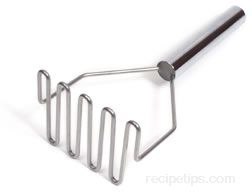
Potato Masher
A kitchen utensil used to mash potatoes after they are cooked or to puree other soft foods for making food dishes requiring a smooth textured ingredient. Potato mashers are typically made of stainless steel or nylon and are available in a variety of different styles, all working equally well. When making mashed potato dishes, mashed sweet potatoes, or to puree ingredients to make baby food, a sturdy masher makes the preparation process very easy.
Potato Preparation
The skin of a potato is edible, so the potato can be prepared with the skins on or with the skins off. Whether the skins are peeled off or left on will depend on personal preference, the type of dish they are being prepared for and the preparation instructions that are called for in the recipe.
Skins Left On
|
Scrub the potato under cold running water to remove any dirt remaining on the skin. |
 |
|
Using a sharp utility knife or the tip of a vegetable peeler, remove eyes, blemishes or green spots. If more than half of the potato is green, dispose of the potato because it will be bitter and the green portion contains solanine, which is slightly toxic. |
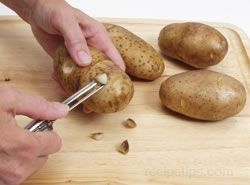 |
Skins Peeled Off
|
Scrub potatoes under cold water and then remove skin by peeling with a vegetable peeler or using a sharp utility knife. |
 |
|
Remove all the skin and then remove any green spots or blemishes that remain. |
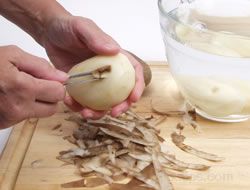 |
| When the potato is completely peeled, place it in cold water immediately until ready to cook or ready to cut to desired size. The cold water will prevent the outer surface of the potato from discoloring. |
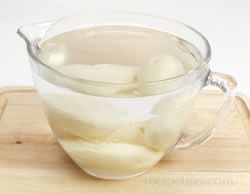 |
Potato Cooking
Boiled | Mashed | Baked | Microwaved | Fried | Grilled
Boiled Potatoes
The skins can be left on to help retain shape and hold in nutrients, but if the potatoes are going to be mashed, they will need to be peeled immediately to assure that they stay hot for mashing. Removing the skins immediately after they are cooked is difficult because the hot potatoes are hard to handle.
Mashed potatoes
|
Boil as shown above.
After draining the potatoes, put them back in the pan they were cooked in and place back on the burner. Evaporate excess moisture over low heat for 1 to 2 minutes. Shake the pan to turn the potatoes and to keep them from sticking to the bottom. Potatoes will break up a little and become drier and brighter in color. |
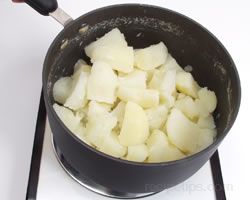 |
|
Mash potatoes by using a potato ricer, potato masher, or an electric beater on low speed. Blend to desired smoothness. |
 |
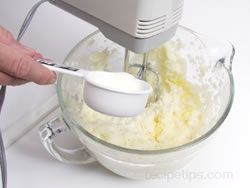 |
 |
| Stir in softened butter (not melted) and then add hot milk. Only add 1/4 cup of milk at a time to control the amount that is added. Add milk until the potatoes are the desired consistency. |
Baked Potatoes
|
Preheat oven to 400°F.
Prepare as shown above for Skins Left On.
Poke through skin with a fork a few times before placing in the oven. The holes will provide a place for steam to escape, preventing the potatoes from bursting, and they will help produce dry & fluffy potatoes. |
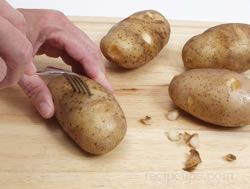 |
|
Do not wrap in foil. The foil traps the moisture in the potato, creating a mushy, wet textured potato. For crispier skins, lightly coat the skins with oil or butter. For tender skins leave them uncoated. |
 |
|
Bake for 1 to 1 1/2 hours, until potatoes are tender when poked with a fork. Time will vary depending on the size of the potatoes.
If baking with other food that requires baking at 350°F, increase cooking time 15 to 20 minutes for the potatoes. |
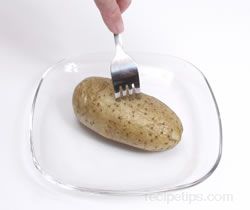 |
Microwave Baked Potatoes
- Scrub potatoes under cold running water to clean and remove any blemishes or green spots.
- Poke through skin with a fork a few times before placing in the microwave. The holes will provide a place for steam to escape, preventing the potatoes from bursting.
- For one potato, microwave for 6 minutes. For more than one potato, microwave as follows: two potatoes for 8 minutes, three potatoes for 10 minutes, 4 potatoes for 12 minutes. Rotating halfway through cooking time.
- Check for doneness by poking with a fork. Potatoes should be tender. If the potatoes are not done, continue to microwave at 1 minute intervals until done.
- Allow the potatoes to stand for 5 minutes before serving.
Fried Potatoes
Grilled Potatoes
There are many ways in which potatoes can be cooked on the grill. They can be cooked as whole potatoes, in halves, slices, or wedges. They are generally grilled with the skins on but can be grilled without. The following methods of grilling are some of the ways that potatoes can be cooked on the grill.
Potato Slices with Skins On
Potato Wedges with Skins On
|
Wash potatoes and dry with a paper towel. Do not peel. Cut potatoes in half lengthwise and then into 1 inch wide wedges. |
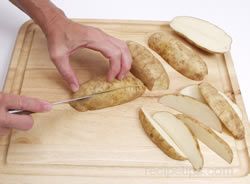 |
|
Brush the wedges with cooking oil immediately to prevent them from turning brown and to help prevent them from sticking to the grate when placed on the grill. |
 |
| Place the wedges on the grill over medium direct heat with one of the cut sides down. Cook for 5 to 6 minutes and turn to the other cut side. Cook on second side for 5 to 6 minutes and then turn wedges so the skin side is down. Finish cooking until tender. Potatoes wedges should be nicely brown. Serve while hot. |
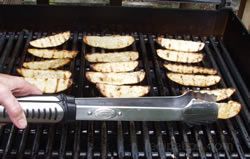 |
New Potatoes - Whole with Skins On
Tips
- Prevent the darkening of a just peeled potato by cooking it immediately or placing it in cold water until ready to use.
- To prevent a peeled potato from falling apart during cooking, soak in cold salt water for 10-15 minutes prior to cooking.
- Add a little lemon juice or a teaspoon of vinegar to the water when boiling potatoes to prevent them from discoloring.
- When cooking potatoes to use in potato salad, add a little vinegar to the water when boiling the potatoes. The vinegar causes the potatoes to form a thin crust, which helps them hold their shape.
|
















 Austrian Crescent
Austrian Crescent Buttercream Potato
Buttercream Potato



 Beauregard
Beauregard









